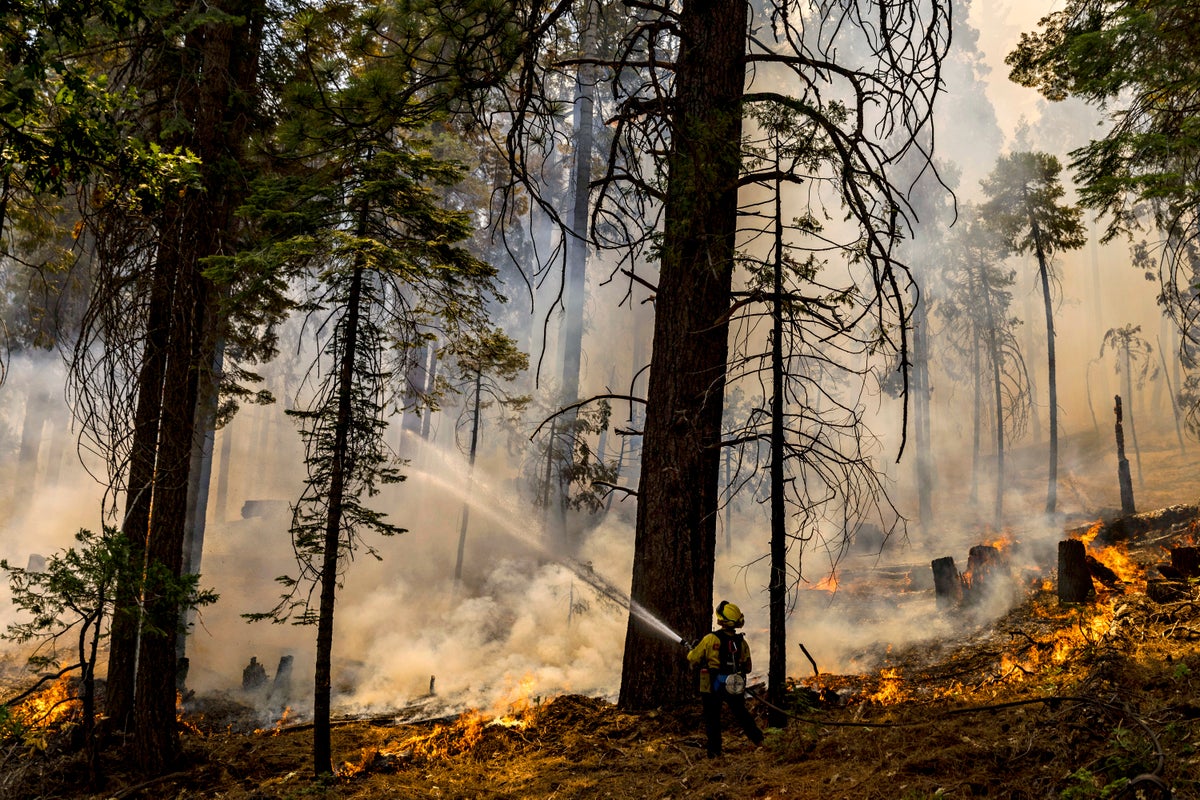
A wildfire on the edge of a grove of California's giant sequoias in Yosemite National Park grew overnight but remained partially contained Tuesday.
The 6-day-old fire was not expected to make a significant advance into the famed Mariposa Grove, an official told a community meeting Monday evening.
“Overall it’s in a very good place,” said Matt Ahearn, the incident management team's tactical operations commander.
Yosemite forest ecologist and firefighter Garrett Dickman also expressed optimism in an interview with SFGATE.com after surveying the western part of the grove on Sunday.
“I walked through all the parts that burned and did not see any mortality. … Some of the trees had some burn on them, but the level of burn was well within their ability to handle it,” Dickman said.
The Washburn Fire at the south end of the park covered about 5 square miles (13 square kilometers) but was still 22% contained Tuesday morning, according to an incident update.
The fire has been burning since Thursday, when visitors reported smoke near Washburn Trail in the area of Mariposa Grove, a stand of hundreds of iconic trees that includes the 3,000-year-old Grizzly Giant.
The next day, hundreds of visitors and residents were evacuated from the nearby community of Wawona, but the rest of Yosemite has remained open.
Sprinklers were set up in the grove to protect the ancient trees, and a structure protection group of firefighters prepared defenses for Wawona.
The fire generally has burned to the north and east, away from the grove. Conditions have been hot and dry but winds have been light.
Ahearn, the tactical operations commander, described extensive work by firefighters to cut off the fire's movements in difficult terrain.
“We're feeling very confident with the plan but we are being challenged with the plan,” he said. “All crews are fully engaged, fully supportive, fighting fire very aggressive.”
Ahearn expressed optimism about keeping the famous grove safe from the fire.
“It's out on the outer skirts of the Mariposa Gove,” Ahearn said. “It has backed a little ways into that, but it hasn't backed intensely into the grove."
Ahearn said firefighters have been clearing around the bases of the trees.
“We fully do not see fire advancing (in) from this point where we're currently at,” he said.
Firefighters had cut by hand a containment line across the entire northern edge of Mariposa Grove, he said.
Firefighters were mindful of the possibility the flames could move farther east and south, which could bracket one end of the grove.
The fire's cause remained under investigation but authorities consider it human-caused because there was no obvious natural spark
The giant sequoias, native in only about 70 groves spread along the western slope of the Sierra Nevada, were once considered impervious to flames but have become increasingly vulnerable as wildfires, fueled by a buildup of undergrowth from a century of fire suppression and the impact of drought exacerbated by climate change, have become more intense and destructive.
Lightning-sparked wildfires over the past two years have killed up to a fifth of the estimated 75,000 large sequoias, which are the biggest trees by volume and a major draw for tourists.
A fierce windstorm ripped through the grove more than a year ago and toppled 15 giant sequoias, along with countless other trees.
The downed trees, in addition to massive numbers of pines killed by bark beetles, provided ample fuel for the flames.
In Utah, smoke and ash emanating from a growing wildfire in rural Tooele County blew into Salt Lake City on Saturday. By Monday night, the Jacob City Fire had grown to 6.4 square miles (16.6 square kilometers), with 19% containment, officials said.
Elsewhere in Utah, firefighters contending with heavy winds battled the 15.9 square-mile (41-square-kilometer) Halfway Hill Fire in Filmore. Law enforcement on Saturday arrested four men who investigators said abandoned a campfire that ignited the blaze.
So far in 2022, over 35,000 wildfires have burned nearly 4.7 million acres (1.9 million hectares) in the U.S., according to the National Interagency Fire Center, well above average for both wildfires and acres burned.







